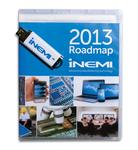iNEMI (International Electronics Manufacturing Initiative)

iNEMI is an industry-led consortium focused on identifying and closing technology gaps, which includes the development and integration of the electronics industry supply infrastructure.
The International Electronics Manufacturing Initiative’s mission is to identify and close technology gaps, which includes the development and integration of the electronics industry supply infrastructure. This industry-led consortium is made up of more than 65 manufacturers, suppliers, industry associations and consortia, government agencies and universities. iNEMI roadmaps the needs of the electronics industry, identifies gaps in the technology infrastructure, establishes implementation projects to eliminate these gaps (both business and technical), and stimulates standards activities to speed the introduction of new technologies. The consortium also works with government agencies, universities and other funding agencies to set priorities for future industry needs and R&D initiatives. iNEMI is based in Herndon, Virginia (near Washington, D.C.), with regional offices in Shanghai, China and Limerick, Ireland. For additional information, visit www.inemi.org.
iNEMI (International Electronics Manufacturing Initiative) Postings
8 technical articles »
Sep 08, 2021 | Richard Parker, Richard Coyle, Gregory Henshall, Joe Smetana, Elizabeth Benedetto
The Pb-Free Alloy Characterization Program sponsored by International Electronics Manufacturing Initiative (iNEMI) is conducting an extensive investigation using accelerated temperature cycling (ATC) to evaluate ball grid array (BGA) thermal fatigue performance of 12 commercial or developmental Sn based Pb-free solder alloys. This paper presents the initial findings from a specific subset of the temperature cycling test matrix. The focus is on comparing alloy performance for two of the most commonly specified temperature cycles, 0 to 100 °C and -40 to 125 °C....
iNEMI Project on Process Development of BiSn-Based Low Temperature Solder Pastes
May 13, 2021 | Haley Fu, Raiyo Aspandiar, Jimmy Chen, Shunfeng Cheng, Qin Chen, Richard Coyle, Sophia Feng, Mark Krmpotich, Ronald C. Lasky, Scott Mokler, Jagadeesh Radhakrishnan, Morgana Ribas, Brook Sandy-Smith, Kok Kwan Tang, Greg Wu, Anny Zhang, Wilson Zhen
The 2017 iNEMI Board and Assembly Roadmap forecasts that, due to economic, environmental and technical drivers, use of low temperature solder pastes will increase significantly and reach 10% of all solder paste used for board assembly by 2021....
Investigation of Factors That Influence Creep Corrosion
Apr 08, 2021 | Cherie Chen
Understand the sensitivities of the identified factors to Creep Corrosion. Correlate experimental test conditions to environment classification standards....
Qualification Test Development for Creep Corrosion
Apr 08, 2021 | Prabjit Singh Simon Lee
Creep corrosion is not a new phenomenon, it has become more prevalent since the enactment of the European Union's Restriction of Hazardous Substance (RoHS) Directive on 1 July 2006. The directive bans the use of lead and other hazardous substances in products (where lead-based surface finishes offered excellent corrosion resistance). The higher melting temperatures of the lead-free solders and their poor wetting of copper metallization on PCBs forced changes to PCB laminates, surface finishes and processing temperature-time profiles. As a result, printed circuit boards might have higher risk of creep corrosion....
May 08, 2019 | Jeffrey ChangBing Lee, Cheng-Chih Chen, Alice Lin, Dem Lee - iST- Integrated Service Technology, Inc., Gary Long, Consultant, Masahiro Tsuriya - INEMI, JAPAN
Cold ball pull testing is used to validate the resistance of PCB pad cratering for the different ultra-low loss dielectrics materials (Dk=3~4.2 and Df <= 0.005 @ 1GHz) in the study. The materials were fabricated in multiple PCB shops using a common test board design utilizing a coupon to result in a 16 mil nominal pad size for the pulls. After fabrication, a 20 mil SAC305 ball is SMT attached to the 16 mil nominal pads for pulling. Each material had 3 coupons with 50 pull locations on each to generate 150 data points for statistical analysis. The peak pull force differences of the material builds can be compared to differentiate the results. As a result, the different ultra-low loss dielectric material’s performance to withstand PCB pad cratering can be compared comprehensively with the cold ball pull test....
Relative Humidity Dependence of Creep Corrosion on Organic-Acid Flux Soldered Printed Circuit Boards
May 09, 2018 | Haley Fu - iNEMI, Prabjit Singh - IBM Corporation, Dem Lee, Jeffrey Lee - iST-Integrated Service Technology, KarlosGuo, Julie Liu - Lenovo, Simon Lee, Geoffrey Tong - The Dow Chemical Company, Chen Xu - Nokia
Creep corrosion on printed circuit boards (PCBs) is the corrosion of copper metallization and the spreading of the copper corrosion products across the PCB surfaces to the extent that they may electrically short circuit neighboring features on the PCB. The iNEMI technical subcommittee on creep corrosion has developed a flowers-of-sulfur (FOS) based test that is sufficiently well developed for consideration as an industry standard qualification test for creep corrosion. This paper will address the important question of how relative humidity affects creep corrosion. A creep corrosion tendency that is inversely proportional to relative humidity may allow data center administrators to eliminate creep corrosion simply by controlling the relative humidity in the data center,thus, avoiding the high cost of gas-phase filtration of gaseous contamination. The creep corrosion relative humidity dependence will be studied using a modified version of the iNEMI FOS test chamber. The design modification allows the achievement of relative humidity as low as 15% in the presence of the chlorine-releasing bleach aqueous solution. The paper will report on the dependence of creep corrosion on humidity in the 15 to 80% relative humidity range by testing ENIG (gold on electroless nickel), ImAg (immersion silver) and OSP (organic surface preservative) finished PCBs, soldered with organic acid flux....
Testing Printed Circuit Boards for Creep Corrosion in Flowers of Sulfur Chamber
Jul 16, 2015 | Haley Fu; iNEMI, Prabjit Singh, Levi Campbell, Jing Zhang; IBM Corporation, Wallace Ables; Dell Corporation, Dem Lee, Jeffrey Lee; iST-Integrated Service Technology, Jane Li, Solomon Zhang; Lenovo Limited Corporation, Simon Lee; The Dow Chemical Company.
Qualification of electronic hardware from a corrosion resistance standpoint has traditionally relied on stressing the hardware in a variety of environments. Before the development of tests based on mixed flowing gas (MFG), hardware was typically exposed to temperature-humidity cycling. In the pre-1980s era, component feature sizes were relatively large. Corrosion, while it did occur, did not in general degrade reliability. There were rare instances of the data center environments releasing corrosive gases and corroding hardware. One that got a lot of publicity was the corrosion by sulfur-bearing gases given off by data center carpeting. More often, corrosion was due to corrosive flux residues left on as-manufactured printed circuit boards (PCBs) that led to ion migration induced electrical shorting. Ion migration induced failures also occurred inside the PCBs due to poor laminate quality and moisture trapped in the laminate layers....
PCB Dynamic Coplanarity At Elevated Temperatures
Nov 10, 2011 | John Davignon, Ken Chiavone, Jiahui Pan, James Henzi, David Mendez, Ron Kulterman
With the advent of larger packages and higher densities/pitch the Industry has been concerned with the coplanarity of both the substrate package and the PCB motherboard. The iNEMI PCB Coplanarity WG generated a snapshot in time of the dynamic coplanarity ...
21 news releases »
iNEMI Publishes White Paper Proposing a Methodology to Determine Risk of Counterfeit Use
![]() Jun 07, 2013 | The Counterfeit Components Project of the International Electronics Manufacturing Initiative (iNEMI) today released a whitepaper entitled, "Development of a Methodology to Determine Risk of Counterfeit Use."
Jun 07, 2013 | The Counterfeit Components Project of the International Electronics Manufacturing Initiative (iNEMI) today released a whitepaper entitled, "Development of a Methodology to Determine Risk of Counterfeit Use."
iNEMI Webinar Will Share Tools Developed to Assess Risk of Counterfeit Components
![]() May 23, 2013 | The Counterfeit Components Assessment Project of the International Electronics Manufacturing Initiative (iNEMI) will hold two open webinars to help the electronics manufacturing supply chain better manage their risk of counterfeit components.
May 23, 2013 | The Counterfeit Components Assessment Project of the International Electronics Manufacturing Initiative (iNEMI) will hold two open webinars to help the electronics manufacturing supply chain better manage their risk of counterfeit components.
iNEMI Publishes its Tenth Roadmap
![]() May 14, 2013 | Cloud computing, sustainability & recycling, and the explosive growth of
MEMS & sensors are among leading trends
May 14, 2013 | Cloud computing, sustainability & recycling, and the explosive growth of
MEMS & sensors are among leading trends
iNEMI Survey Asks about Boundary Scan Adoption
![]() Feb 06, 2009 | Input will help the electronics industry improve test implementation and coverage
Feb 06, 2009 | Input will help the electronics industry improve test implementation and coverage
![]() Apr 23, 2008 | European workshop scheduled for 18 June at IMEC in Leuven, Belgium
Apr 23, 2008 | European workshop scheduled for 18 June at IMEC in Leuven, Belgium
iNEMI Schedules Regional Roadmap Workshops
![]() Mar 24, 2008 | North American workshop is May 14
Mar 24, 2008 | North American workshop is May 14
iNEMI Names Grace O�Malley Manager of Operations for Europe
![]() Nov 13, 2007 | Photo available (see note at end of release)
Nov 13, 2007 | Photo available (see note at end of release)
Wiley-IEEE Press Publishes iNEMI Lead-Free Book
![]() Nov 02, 2007 | Book provides in-depth information for implementing
Nov 02, 2007 | Book provides in-depth information for implementing
iNEMI Previews Highlights of 2007 Roadmap at IPC Printed Circuits Expo, APEX and Designers Summit
![]() Jan 15, 2007 | Forum on lead-free processes and summit on reliability are also planned
Jan 15, 2007 | Forum on lead-free processes and summit on reliability are also planned
iNEMI Organizes Task Group to Address Availability of SnPb BGAs
![]() Nov 08, 2006 | Workshop Scheduled for January 24 in Silicon Valley
Nov 08, 2006 | Workshop Scheduled for January 24 in Silicon Valley
11 more news releases from iNEMI (International Electronics Manufacturing Initiative) »








